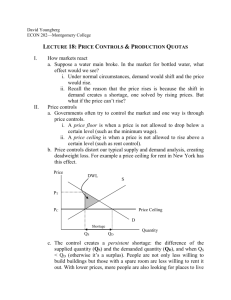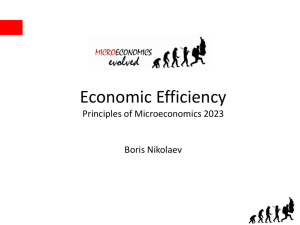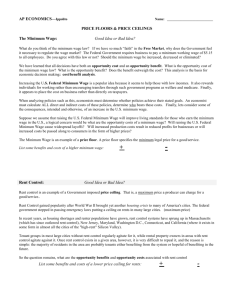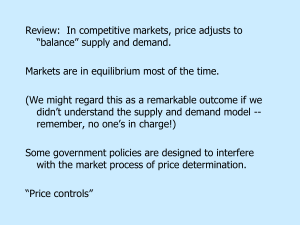unemployment
advertisement
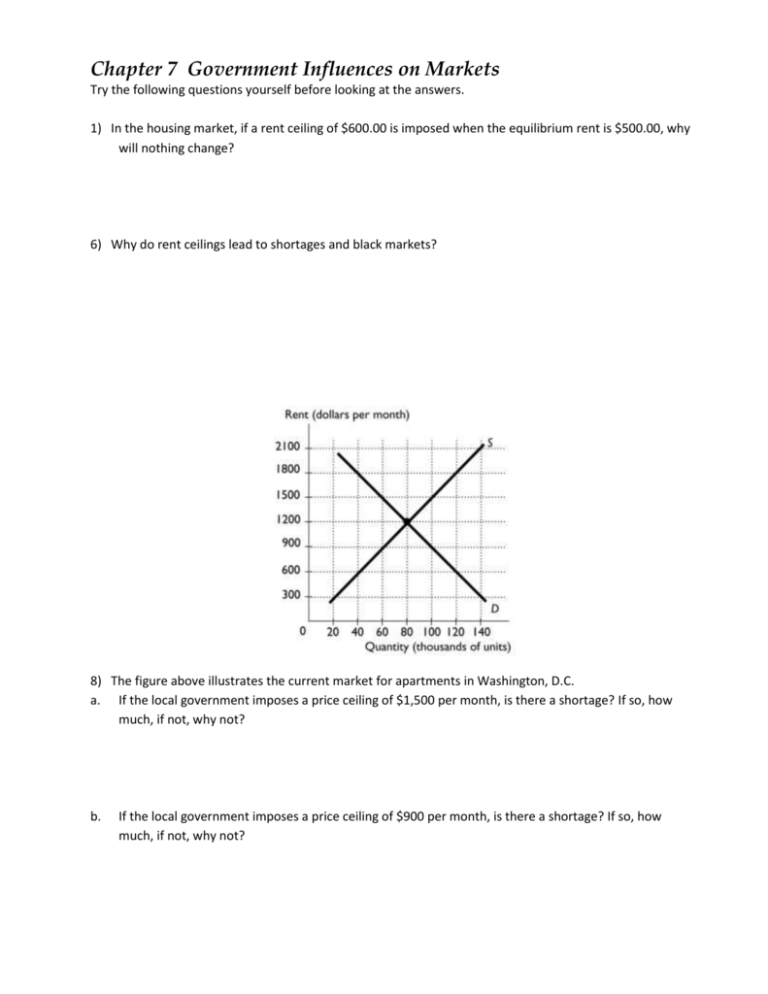
Chapter 7 Government Influences on Markets Try the following questions yourself before looking at the answers. 1) In the housing market, if a rent ceiling of $600.00 is imposed when the equilibrium rent is $500.00, why will nothing change? 6) Why do rent ceilings lead to shortages and black markets? 8) The figure above illustrates the current market for apartments in Washington, D.C. a. If the local government imposes a price ceiling of $1,500 per month, is there a shortage? If so, how much, if not, why not? b. If the local government imposes a price ceiling of $900 per month, is there a shortage? If so, how much, if not, why not? 11) Compare and contrast a price ceiling and a price floor. 12) Will an increase in the minimum wage create more unemployment if the supply and demand for labor are highly elastic or highly inelastic? Good one! 13) Why would an increase in the minimum wage to $15 per hour lead to more unemployment for teenage and low-skilled workers? 15) How does the elasticity of demand for labor affect the deadweight loss from an increase in the minimum wage? Why? Tough one! 16) Discuss the inefficiencies created by a price floor. 18) We know that the minimum wage causes unemployment. So, why does the government impose one? 21) What is a price support program in an agricultural market? Explain its impact on a market. 22) Who gains from a price support? Who loses? Explain how the size of the gain compares to the size of the loss. 23) Suppose that producers are richer than consumers. Is a price support program fair? Explain your answer. Chapter 7 Government Influences on Markets 1. Answer: A rent ceiling is the maximum legal rent. Generally, the government imposes the ceiling when the equilibrium rent is considered too high. If, however, the rent ceiling ($600.00) is above the equilibrium rent ($500.00), people are already paying a rent lower than legal maximum. As a result, nothing changes and so this price ceiling is ineffective. 6 Answer: Rent ceilings that are set below the market equilibrium price for apartments lead to shortages for two reasons. First, the lower price increase the quantity of apartments demanded. Second, the quantity of apartments supplied decreases and, over time, the supply decreases even more because of the lower rent. When the quantity demanded exceeds the quantity supplied, a shortage is created. Faced with the inability to obtain the product they want, in this case, housing, people use bribes and other inducements in the black market to increase their chances of moving up the waiting list that emerges in the rent-controlled apartment market. Not everyone participates in the black market, but rent ceilings will favor those people willing to engage in illegal transactions. 8 Answer: a. There is not a shortage. The equilibrium rent is $1,200 a month. Because the rent ceiling is above the equilibrium rent, it has no effect. b. There is a shortage. At a rent of $900 per month, the quantity of units demanded is 100,000 and the quantity of units supplied is 60,000. Hence there is a shortage of 40,000 units. 11 Answer: A price ceiling is the maximum legal price that may be charged. A price floor is the minimum legal price that may be charged. For a price ceiling or a price floor to have an effect, they must make the equilibrium price illegal. So, an effective price ceiling is set below the equilibrium price while an effective price floor is set above the equilibrium price. A price ceiling creates a shortage of the good while a price floor creates a surplus. Both create inefficiency because the marginal benefit of the last unit consumed no longer equals the marginal cost of the last unit produced. 12 Answer: An increase in the minimum wage creates less unemployment when the supply and demand for labor are highly inelastic. If the supply and demand for labor are highly elastic, an increase in the minimum wage leads to more unemployment because the quantity of labor supplied increases significantly and the quantity of labor demanded decreases significantly. If they are inelastic, an increase in the minimum wage leads to only a small decrease in the quantity of labor demanded and only a small increase in the quantity of labor supplied, so that the resulting unemployment is not very large. 13 Answer: Many teenage and low-skilled workers earn far less than $15 per hour. Hence a price floor in the labor market that "guaranteed" a wage of $15 per hour, that is, a minimum wage of $15 per hour, would have a double-edged effect. First, the quantity of labor supplied would increase because more people would be willing and able to work for the higher wage. Indeed, some high school students would drop out of school in order to obtain work if they thought they would be paid $15 an hour. Second, many businesses would be unwilling and unable to pay $15 per hour and would therefore lay off many teenage and low-skilled workers. In other words, the quantity of labor supplied increases and the quantity of labor demanded decreases. The resulting surplus of labor means a higher unemployment rate for the very people the minimum wage is designed to help. 15 Answer: The more elastic the demand for labor, the greater the deadweight loss from increasing the minimum wage. Essentially, the more elastic the demand for labor, the larger the decrease in the quantity of labor demanded when the minimum wage rate rises. As a result, the larger the decrease in employment and hence the greater is the deadweight loss. 16 Answer: A price floor prevents the efficient allocation of resources. If a price floor is set above the equilibrium price, the quantity of the good or service supplied increases and the quantity demanded decreases, so that a surplus results. The minimum wage is a price floor. If the minimum wage is set above the equilibrium wage rate, the surplus of labor means increased unemployment. Similar to all price floors, the minimum wage creates inefficiency. The minimum wage leads to inefficiency because at the minimum wage, marginal benefit to a firm from hiring another worker exceeds the marginal cost to a worker from working. 18 Answer: The main reason for the minimum wage is because its supporters outnumber its opponents. Some supporters, such as labor unions, have a self-interested motivation for seeing a high minimum wage. A high minimum wage increases the cost of low-skilled labor, which is a substitute for high-skilled union labor. Hence firms decrease the quantity of low-skilled labor they demand and increase their demand for union labor, thereby increasing the employment and wages of union labor. Other supporters point to the fact that the minimum wage helps raise the incomes of low-skilled workers who retain jobs. Also, if the demand and supply of low-skilled workers is inelastic, the resulting unemployment will be low and so supporters might believe that helping some low-skilled workers is worth harming others. 21 Answer: A price support program is essentially a price floor in an agricultural market. The government typically: ∙ Isolates the domestic market from global competition by restricting imports from the rest of the world; ∙ Introduces a price floor, which in an agricultural market is called a "price support." The government guarantees to buy at this price; ∙ Pays a subsidy to the farms by buying the surplus crop that is produced. A price support leads to a decrease in the quantity consumed by private consumers. The government must buy the surplus crop produced. And a deadweight loss is created. 23 Answer: Producers gain from a price support because the price of the good or service increases. As a result, the producer surplus increases. Consumers lose from a price support because the price the good or service increases. As a result, the consumer surplus decreases. Because a price support program creates a deadweight loss, it is the case that the decrease in consumer surplus exceeds the increase in producer surplus. 23 Answer: A price support program is unfair. It is unfair under the fair rules approach to fairness because a price support prevents voluntary exchange. And, if producers are richer than consumers, it is unfair under a fair results approach because the price support further enriches the (already rich) producers while decreasing the income of the (already poor) consumers. So in this case a price support redistributes income from the poor to the rich.

